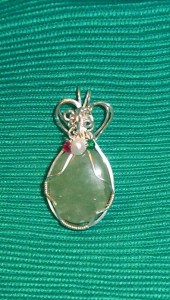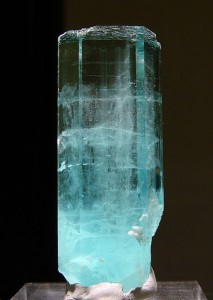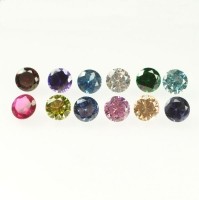- NEW DVD Series – Stone Setting with Bezels
- Tube Set Charm by Kim St. Jean
- Prong Basket Pendant by Kim St. Jean
- NEW DVD Series – Stone Setting with Cold Connections
- New DVD Series – Stone Setting with Wire
- NEW DVD Series: Introduction to Stone Setting by Kim St. Jean
- Featured Tool: Bracelet Bending Plier
- NEW Dvd by Eva Sherman
- Fun, Fast Fold Forming DVD Series
- Double Band Ear Cuff from Alex Simkin
Gem Profile August 3: Aquamarine
by Rose Marion, Wire-Sculpture.com

Aquamarine
Shop Aquamarine Beads | Shop Aquamarine CZs
Aquamarine, the sky-blue gem, is a member of the beryl family, making it siblings with emerald, golden beryl, goshenite, and morganite. The birthstone for March, aquamarine has a Moh’s hardness of 7.5-8 – just a touch harder than quartz! – making it perfect for everyday jewelry. To clean aquamarine, simply clean with mild dish soap, using a toothbrush to clean behind prongs or settings.
Chemically speaking, while the quartz family is made up of silicone dioxide, a mixture of the elements silica and oxygen, beryl family members are made up of beryllium, aluminum, and silica. Aquamarine’s misty color comes from trace amounts of iron in its crystalline structure.

Karren Vitt created this aquamarine pendant for her daughter-in-law: it holds 4 birthstones, including aquamarine for her daughter-in-law’s March birthday.
Aquamarine comes from the Latin for sea water, which is absolutely fitting, because aquamarine is known for its range from pastel blue to pale green. Legend has it that sailors carried it to keep them safe at sea, and that aquamarine is the treasure of mermaids!
While deep blue aquamarine is considered the most valuable, with sky-blue aquamarine a more affordable and much-loved favorite, aquamarine is also cherished for its irregularities. Beryls, including aquamarine, can have long, hollow, tubular “inclusions,” which can bring great value to the stone. This is because an experienced gemcutter can produce cat’s eyes or asterisms if there are enough “tubes” in the stone. (What is asterism? Well, a cabochon that’s cut to show a cat’s eye typically has a highlighted, shiny area, like the slit of a cat’s eye, up-and-down; in asterism, not only is there a cats-eye effect up-and-down, but also side-to-side (and sometimes even diagonally) – creating a shining star effect!) Some other stones beside aquamarine that can have asterisms are sapphire, ruby, tiger’s-eye, and diopside (black star diopside).
While aquamarine is mined in many countries, including Pakistan, Sri Lanka, China, Russia, Nigeria, Madagascar, Zambia, and Mozambique, most of the aquamarine on the market today is from Brazil – and of good quality, too. Some aquamarine has also been found in pockets of the US, including Colorado, Idaho, California, and parts of the Atlantic coast. With that list of countries, aquamarine sounds fairly abundant: however, due to the stone’s color being so delicate and pale, it takes a good-size stone to present the aquamarine “look” properly, which means the rough must be even bigger; and while there is a lot of aquamarine crystal out there, good crystals that are large enough to cut and facet can be rare. With that being said, the largest gem-quality aquamarine was mined in Marambaia, Brazil, in 1910, measuring 19 inches long and 17 inches in diameter – that’s gigantic!
When mined, aquamarine is usually found with deposits of other rocks, ores, and gems such as tin, granite, feldspar, and tourmaline.
Most aquamarines have a natural greenish, almost yellow-green tint; to turn the green into a pure blue color, aquamarine is heated to 375 degrees Celsius (about 700 degrees Farenheit). This treatment was widespread until very recently, when the general public began to understand aquamarine’s natural coloring. Proper heat treatment alters nothing about the stone but its color, so while most pure blue aquamarine on the market is heat treated, it is still perfectly stable and a real stone.

Terri McMahon wire wrapped this 15x13mm piece of raw aquamarine, in 21-gauge square sterling silver wire.
According to one source I found, Gemsociety.org, a beautiful deep-dark blue aquamarine came on the market several decades ago that was named Maxixe aquamarine (pronounced ma-she’-she). Maxixe aquamarine is irradiated to enhance the color, but the treatment wasn’t stable, so the color can turn – or so that article said. However, I also found a claim that Maxixe comes naturally from Madagascar, and while its natural deep blue color can turn to white when exposed to sunlight or heat treatment, the color can be brought back with irradiation. While I can’t be sure which Maxixe story is true, it is always best to use common sense: deep blue aquamarine is highly valuable, and should have a high price tag: if it doesn’t, it’s probably not what it appears to be!
Next Friday’s Gem Profile is on Emerald! Have you made wire jewelry with emerald before? Send your emerald pictures to tips@wire-sculpture.com, and they could be featured!
Resources & Recommended Reading
- Asterisms and Chatoyancy
- Aquamarine on Gemsociety.org
- What is Aquamarine
- Aquamarine on Minerals.net
- Aquamarine on AGTA
- Aquamarine on Wikipedia
Gem Profile by Rose Marion
Click to Receive Daily Tips by Email
























Beth
August 3, 2012 at 7:56 pm
I LOVE Aquamarine! It is my birthstone and I have a beautiful three-stone ring that I wear everyday with aquamarines set in it! I just love how much the color of the stone can vary from sample to sample! Thank you so much for highlighting such a beautiful and sometimes rare stone!
Moraima Annandsingh
August 6, 2012 at 5:48 am
Thank you very much, I always enjoy reading your gem profiles, so much so that I made a file specially for them, thank you again, and continue bringing information to educate us.
Pingback: Blue Topaz - About Blue topaz, London blue topaz | Jewelry Making Blog | Information | Education | Videos